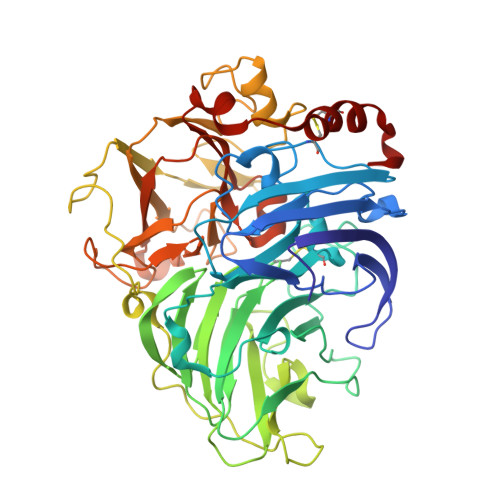Crystal Structure of a Laccase from the Fungus Trametes Versicolor at 1.90-A Resolution Containing a Full Complement of Coppers.
Piontek, K., Antorini, M., Choinowski, T.(2002) J Biological Chem 277: 37663
- PubMed: 12163489
- DOI: https://doi.org/10.1074/jbc.M204571200
- Primary Citation of Related Structures:
1GYC - PubMed Abstract:
Laccase is a polyphenol oxidase, which belongs to the family of blue multicopper oxidases. These enzymes catalyze the one-electron oxidation of four reducing-substrate molecules concomitant with the four-electron reduction of molecular oxygen to water. Laccases oxidize a broad range of substrates, preferably phenolic compounds. In the presence of mediators, fungal laccases exhibit an enlarged substrate range and are then able to oxidize compounds with a redox potential exceeding their own. Until now, only one crystal structure of a laccase in an inactive, type-2 copper-depleted form has been reported. We present here the first crystal structure of an active laccase containing a full complement of coppers, the complete polypeptide chain together with seven carbohydrate moieties. Despite the presence of all coppers in the new structure, the folds of the two laccases are quite similar. The coordination of the type-3 coppers, however, is distinctly different. The geometry of the trinuclear copper cluster in the Trametes versicolor laccase is similar to that found in the ascorbate oxidase and that of mammalian ceruloplasmin structures, suggesting a common reaction mechanism for the copper oxidation and the O(2) reduction. In contrast to most blue copper proteins, the type-1 copper in the T. versicolor laccase has no axial ligand and is only 3-fold coordinated. Previously, a modest elevation of the redox potential was attributed to the lack of an axial ligand. Based on the present structural data and sequence comparisons, a mechanism is presented to explain how laccases could tune their redox potential by as much as 200 mV.
Organizational Affiliation:
Institute of Biochemistry, Swiss Federal Institute of Technology (ETH), ETH-H?nggerberg, Building HPM, Room D 8.1-2, CH-8093 Z¨¹rich, Switzerland. klaus.piontek@bc.biol.ethz.ch



















